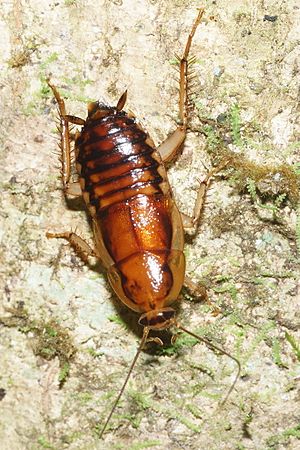Celatoblatta facts for kids
Quick facts for kids Celatoblatta |
|
|---|---|
 |
|
| Celatoblatta undulivitta | |
| Scientific classification |
|
| Kingdom: | Animalia |
| Phylum: | Arthropoda |
| Class: | Insecta |
| Order: | Blattodea |
| Family: | Blattidae |
| Genus: | Celatoblatta Johns, 1966 |
Celatoblatta is a group, or genus, of cockroaches. These insects belong to the family Blattidae. You can find different kinds of Celatoblatta cockroaches in places like Australia, New Zealand, and New Caledonia. They are part of the natural world in these regions.
Contents
What are Celatoblatta Cockroaches?
Celatoblatta is a genus of cockroaches. This means it's a scientific grouping of many similar species. These insects are known for being very old creatures on Earth. They have been around for millions of years. Cockroaches are often seen as pests, but they play a role in their ecosystems.
Where Do Celatoblatta Live?
The different species of Celatoblatta are found in specific parts of the world. They live in Australia, New Zealand, and New Caledonia. These areas have unique environments. Cockroaches often prefer warm, damp places. They can be found in forests, under rocks, or in leaf litter. Their habitat helps them stay hidden and find food.
What Do They Look Like?
Like other cockroaches, Celatoblatta species have flat bodies. They usually have two antennae, which are like feelers. These help them sense their surroundings. Most cockroaches have six legs for moving quickly. Some species have wings, while others do not. Their colors can vary, often being shades of brown or black. The image shows an example of Celatoblatta undulivitta.
Many Types of Celatoblatta
There are many different species within the Celatoblatta genus. Each species has its own unique features. Scientists like Johns and Mackerras have identified and named these species. Some examples include Celatoblatta anisoptera and Celatoblatta montana. Each one is adapted to its specific environment.
Their Role in Nature
Cockroaches, including Celatoblatta, are important decomposers. This means they help break down dead plants and animals. They eat decaying matter, which helps recycle nutrients back into the soil. This process is vital for healthy ecosystems. They can also be a food source for other animals.
See also
 In Spanish: Celatoblatta para niños
In Spanish: Celatoblatta para niños

